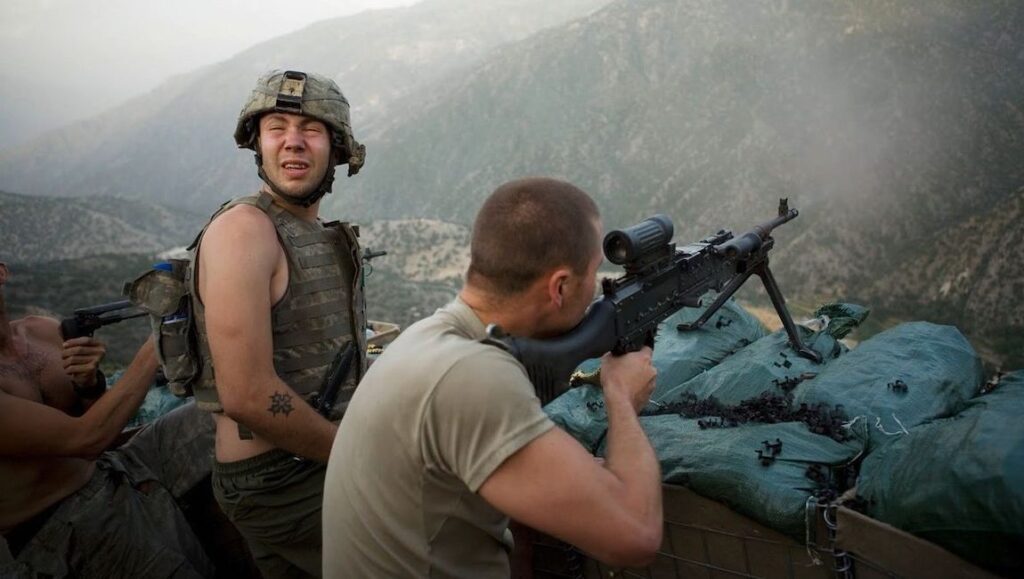Ongoing military conflicts in Afghanistan and Iraq define the last decade of American foreign policy, not only for their historical representation of a shady Bush-era doctrine, but also for the incredible amount of media both have spawned for public consumption. Like the Vietnam War, these conflicts polarize both the civilian population and those deeply entrenched in the fighting. Not surprisingly, this ideological tension overlaps with a simultaneous resurgence of the documentary genre in both popular and critical opinion, along with moderate profitability, making nonfiction the go-to genre for filmmakers, journalists, and human rights activists hoping to shine a light on ignored subject matter in the Middle East and Stateside. This calculated relationship between form and function has produced a landslide of films dealing with the emotional and physical toll modern warfare takes on the American soldier.
In this movement, specific events and ideas have become hotbed issues, such as atrocities perpetrated by the military prison officers at Abu Ghraib (Standard Operating Procedure) and political/media compromises posing as moral justifications (Control Room, Uncovered). But it’s the more personal essays, which focus on the collective soldiers’ POV (such as Gunner Palace), that have pumped the heart of this movement, giving vivid representation of the harrowing individuals embattled in combat. Often shot by the grunts themselves, on hand-held cameras, these films put the viewer in the midst of nightmarish violence, failures of leadership, and massive breakdowns of infrastructure, focusing on the gray areas of war rather than mere political posturing. The selling point here has been the authenticity of their documented experiences, but many of these films tend to lack focus and as a result descend into anarchy.
Restrepo, co-directed by British photographer Tim Hetherington and American author Sebastian Junger, belongs to this fraternity of apolitical docs exploring the lives of soldiers coming to terms with their respective missions and inevitable losses. The film chronicles the year-long deployment of the 2nd Platoon in Afghanistan’s Taliban hotbed the Korengal Valley, attempting to distill the dimensionality of its subjects in first-person interviews, while in the process acclimating us to relentless first-hand combat. The filmmakers express interest in examining the friendship between these men instead of highlighting military hierarchies or mission objectives, and this thematic angle sets Restrepo apart from many films before it. Never is this more clear and effective than in the film’s opening sequence, as a jerky hand-held playfully documents four American soldiers joking and laughing just before deployment. The camera jumps from one perspective to the next, and despite all the typical exuberance and chest-thumping, these men show a connection to each other that transcends stereotypical military brotherhood.
But as Restrepo descends into the Korengal, observing its soldiers as they live under the constant threat of an insurgent attack, the filmmakers follow along without a coherent point of commentary. Hetherington and Junger never construct a convincing audio/visual aesthetic to sort out the torrent of information they present us with. The obvious focus is the death of Medic Restrepo, one of the soldiers seen in the film’s prologue, killed early on during a daytime ambush. His military brothers name a strategic outpost after him, and the filmmakers treat this decision less as a complex allegory than a tangible symbol of psychological warfare. However, as the soldiers’ routines and objectives blur together into one hazy vision of smoke, gunfire, and mortars, the film loses its grip on that study of military camaraderie. The first hour is rife with sloppy montages interrupted by awkward first-person interviews, and Restrepo gets engulfed by live ordinance, seeming shell-shocked as a documentary.
The cracks begin to show almost immediately, as Hetherington and Junger rely on connecting memories in the interviews with footage recorded during the insurgency. Throughout, these juxtapositions don’t hold water, lacking a dramatic and psychological connection between subject and action. The soldiers themselves never gain much personality until the final act, when Restrepo builds a dynamic set piece out of the platoon’s daring mission into enemy territory (an initiative aptly titled “Operation Avalanche”). The captured footage of the squad’s ambush is devastating, even when rendered incomprehensible by the chaotic movement of bodies and the booming cracks of machine-gun fire. But this real-life horror rests on the screen as a shocking example of raw footage, not great cinema. Restrepo doesn’t lay the necessary groundwork necessary to make it anything more than that.
Restrepo often succeeds during scattered passages of potent realism. However, the documentary never convinces as an overarching assessment of the harsh realities and repercussions of the Afghan War. There are glimmers of brilliance, such as one instance of haunting cross-cutting between silent close-ups of the soldiers’ interviews and a shirtless soldier playing the guitar (in a casual requiem for Medic Restrepo), whose prowess on the instrument was said to inspire everyone around him. In this singular moment of remembrance and friendship, Restrepo finds a poignant voice, and this power nearly elevates the entire film. Still, it’s impossible to ignore how easily Restrepo gets overrun by a disjointed cinematic approach, and the disappointment resonates long after the credits roll. Not quite a battle for hearts and minds, Restrepo chooses disorder over focus and gets lost in the fog of war.


Comments are closed.